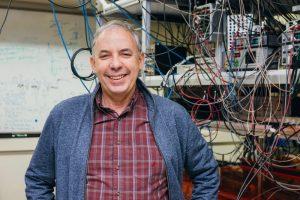Mark Saffman, the Johannes Rydberg Professor of Physics and director of the Wisconsin Quantum Institute, won the American Physical Society’s 2026 Norman F. Ramsey Prize in Atomic, Molecular, and Optical Physics, and in Precision Tests of Fundamental Laws and Symmetries.
The Ramsey prize recognizes outstanding accomplishments in the two fields of Norman Ramsey: atomic, molecular, and optical (AMO) physics; and precision tests of fundamental laws and symmetries. Saffman won “for seminal developments of quantum information processing with neutral atoms that allow the investigation of many-body problems that are intractable by classical computing.” He shares the prize with Antoine Browaeys at the Institut d’Optique in France.

Saffman joined the UW–Madison physics faculty in 1999 with ideas for his research program but struggled to acquire enough funding. Then, he started reading theory papers about the relatively new field of quantum computing and how to develop qubits, or quantum bits.
“This was in an era when people were proposing all these different ideas for qubits,” Saffman says. “I read this paper about using Rydberg gates to entangle atomic qubits and thought, ‘This looks interesting, let’s do that.’ That was the smartest decision I ever made in my career.”
An atom can be induced into a Rydberg state by a strong laser, when one of its outer shell electrons is excited into a very high energy state. The atom is effectively much larger than usual, and can lead to interesting quantum properties. Relatively inexperienced in experimental atomic physics, Saffman approached Thad Walker, a professor in the department and an expert on how to laser cool atoms, about collaborating. A decade later, they had their major success: a Rydberg blockade.
“The basic interaction is that you excite one atom to a Rydberg state and then you cannot excite a second one close by,” Saffman says. “That blockade interaction lies behind the ability to do a logic gate — a CNOT gate — and entangle two qubits.”
A year later, Saffman and Walker demonstrated the first CNOT gate for atomic qubits. These qubits, also called neutral atom qubits, quickly are now one of the leading platforms for achieving fault tolerant quantum computing.
Over the next decade Saffman started to realize that building a fully functional quantum computer was not just a scientific effort, it was a major engineering effort, one that was likely outside the scope of an academic research group.
“It became clear to me that to compete at the forefront, I needed more resources. I wanted to go faster,” Saffman says. “So, I ended up joining forces with ColdQuanta (now Infleqtion), an existing small cold atom sensing and components company .”

Saffman brought his quantum computing ideas to the company as Chief Scientist for Quantum Information at Colorado-based Infleqtion in 2018, and the company now has a satellite office in Madison.
The partnership with Infleqtion did, in fact, accelerate Saffman’s research. In 2022, his group, including long-time scientist and group member Trent Graham, co-authored a paper with engineers at Infleqtion where they demonstrated the first quantum algorithm to be run on an atomic quantum computer. It was a huge proof of principle and significant step forward in the field.
Quantum information research has emerged as a major topic within the AMO physics community. At UW–Madison, Saffman has been a key player in that shift. In 2019, he helped develop the Wisconsin Quantum Institute, an interdisciplinary effort of all quantum information science and engineering researchers on campus. That same year, he was named the institute’s director.
“UW–Madison was one of the first places to have multiple serious efforts in qubits: Thad and I pioneered neutral atoms, (physics professor) Mark Eriksson pioneered silicon spin qubits, (physics professor) Robert McDermott has superconducting qubits,” Saffman says. “Now, a huge fraction of new faculty coming out of academia and starting their own groups are working in quantum information-related science and engineering, including many of our new faculty. The state of quantum computing at UW–Madison is very strong.”